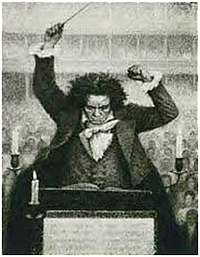genre: Symphony
 The symphony is perhaps the pre-eminent genre of orchestral music, a status it has held since at least the mid-18th century. The term 'symphony' derives from the Greek words syn (together) and phone (sounding), and became common during the Middle Ages and Renaissance in its Latinized form, "symphonia", as a speculative expression connoting musical harmony or consonance. It first became attached to musical works in the early Baroque era, as in Giovanni Gabrieli's Sacrae symphoniae (1597), as a generic reference to works "sounding together" with voices and instruments. By the mid-17th century, the term - in its Italian form "sinfonia" - had become standardized as an instrumental introduction to an opera, oratorio, or other large-scale vocal works, and were generally set in a 3-part slow-fast-slow form. Soon other uses were employed, such as the introduction to an aria, or as the first movement of an instrumental suite or sonata. New trends emerged in the 1720s and 30s, first in Northern Italy, when composers such as Giovanni Battista Sammartini adapted their opera sinfoniae for concert use, and soon composed self-contained sinfoniae or symphonies. This is not to suggest a one-to-one correspondance between the opera sinfonia and the stand-alone symphony, as other genres - including the sonata da camera and the ripieno concerto - were likewise influential in the development of the new genre. Further evolution took place especially in the German town of Mannheim, where the court composer Johann Stamitz assembled a virtuoso orchestra, and with his nearly 60 symphonies helped to conventionalize certain formal aspects of the symphony that were later adopted by the masters of late-18th century Vienna: Franz Joseph Haydn, Wolfgang Amadeus Mozart, and Ludwig van Beethoven. These include a fixed 4-movement form, with the opening Allegro using the rounded binary or "sonata" form. Hadyn, with his 104 mature symphonies, broke open new vistas for the genre in terms of orchestration, expression, and aesthetic power, and helped established the symphony as the most esteemed instrumental genre of the age - a challenge embraced by his younger contemporary Mozart, with his 41 masterful symphonies. Beethoven likewise embraced the symphony as the utlimate vehicle of aesthetic expression - so much so that each of his 9 symphonies became a world unto itself. In his shadow, most composers of the Romantic era took their approach to the symphony very seriously - even apprehensively, as in the case of Johannes Brahms, who waited until age 43 to complete the first of his 4 symphonies. Some composers followed Beethoven's emphasis on the symphony - such as Antonín Dvořák, Anton Bruckner, Pyotr Tchaikovsky, and Gustav Mahler - though its grip began to wane as the late-Romantic era came to a close. A few Modern era composers, most notably Dmitri Shostakovich, continued to focus on the symphony as their dominant creative vehicle, but even those who didn't could not escape its legacy and aesthetic significance - a trend not likely to dissipate in the present century.
The symphony is perhaps the pre-eminent genre of orchestral music, a status it has held since at least the mid-18th century. The term 'symphony' derives from the Greek words syn (together) and phone (sounding), and became common during the Middle Ages and Renaissance in its Latinized form, "symphonia", as a speculative expression connoting musical harmony or consonance. It first became attached to musical works in the early Baroque era, as in Giovanni Gabrieli's Sacrae symphoniae (1597), as a generic reference to works "sounding together" with voices and instruments. By the mid-17th century, the term - in its Italian form "sinfonia" - had become standardized as an instrumental introduction to an opera, oratorio, or other large-scale vocal works, and were generally set in a 3-part slow-fast-slow form. Soon other uses were employed, such as the introduction to an aria, or as the first movement of an instrumental suite or sonata. New trends emerged in the 1720s and 30s, first in Northern Italy, when composers such as Giovanni Battista Sammartini adapted their opera sinfoniae for concert use, and soon composed self-contained sinfoniae or symphonies. This is not to suggest a one-to-one correspondance between the opera sinfonia and the stand-alone symphony, as other genres - including the sonata da camera and the ripieno concerto - were likewise influential in the development of the new genre. Further evolution took place especially in the German town of Mannheim, where the court composer Johann Stamitz assembled a virtuoso orchestra, and with his nearly 60 symphonies helped to conventionalize certain formal aspects of the symphony that were later adopted by the masters of late-18th century Vienna: Franz Joseph Haydn, Wolfgang Amadeus Mozart, and Ludwig van Beethoven. These include a fixed 4-movement form, with the opening Allegro using the rounded binary or "sonata" form. Hadyn, with his 104 mature symphonies, broke open new vistas for the genre in terms of orchestration, expression, and aesthetic power, and helped established the symphony as the most esteemed instrumental genre of the age - a challenge embraced by his younger contemporary Mozart, with his 41 masterful symphonies. Beethoven likewise embraced the symphony as the utlimate vehicle of aesthetic expression - so much so that each of his 9 symphonies became a world unto itself. In his shadow, most composers of the Romantic era took their approach to the symphony very seriously - even apprehensively, as in the case of Johannes Brahms, who waited until age 43 to complete the first of his 4 symphonies. Some composers followed Beethoven's emphasis on the symphony - such as Antonín Dvořák, Anton Bruckner, Pyotr Tchaikovsky, and Gustav Mahler - though its grip began to wane as the late-Romantic era came to a close. A few Modern era composers, most notably Dmitri Shostakovich, continued to focus on the symphony as their dominant creative vehicle, but even those who didn't could not escape its legacy and aesthetic significance - a trend not likely to dissipate in the present century.

Nolan Gasser, PhD
Artistic Director













